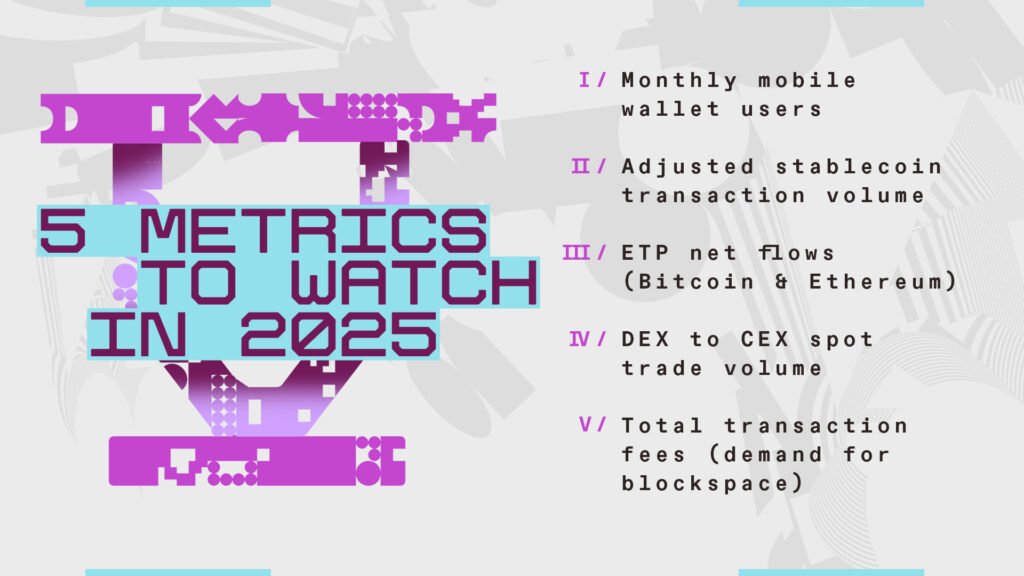🖥️ The development of the crypto industry is becoming more and more mature. At the end of last year, we came up with 5 metrics 📝 to keep an eye on in 2025 to track the continued growth and development of the industry, namely:
Number of monthly mobile wallet users, adjusted stablecoin trading volume, net inflow of ETP funds, ratio of DEX to CEX spot trading volume, total transaction fee (block space requirement)
The following is an analysis of the data and importance for the first half of this year.
1⃣️ Monthly mobile wallet users: +23%. 📈
2025: Average 34.4 million monthly active mobile wallet users;
2024: Monthly active mobile wallet users average 27.9 million.
Explanation of importance:
The wallet infrastructure has improved significantly – we now have low transaction fees, a new account abstraction protocol (EIP-7702), embedded wallet products (Privy, Turnkey, Dynamic), and more. There's never been a better time to build the next generation of mobile wallets.
Related:
This month, Stripe acquired Privy, a leading wallet infrastructure provider.
2⃣️ Adjusted stablecoin trading volume: +49%. 📈
2025: Adjusted stablecoin trading volume averages $702 billion per month;
2024: Adjusted stablecoin trading volume averages $472 billion per month.
Explanation of importance:
Stablecoins have achieved product-market fit. Today, we can transfer USD in less than 1 second and at a cost of less than 1 cent – making stablecoins ideal for payments. Large financial institutions are embracing this opportunity.
Related:
USDC issuer Circle is listed on the New York Stock Exchange;
Stripe acquires stablecoin infrastructure provider Bridge and announces several new products;
Coinbase Releases Smart Payment Standard to Support Stablecoin Payments;
Visa and Mastercard Enhanced Stablecoin Support;
Meta is reportedly in talks to introduce stablecoins as a payment settlement method.
3⃣️ Net inflow of ETP funds (Bitcoin and Ethereum): +28%. 📈
June 2025: total net ETP inflows of $45 billion ($42 billion for Bitcoin and $3.4 billion for Ethereum);
End of 2024: Total net inflows of ETP funds $35 billion ($33 billion for Bitcoin and $2.4 billion for Ethereum).
Explanation of importance:
The entry of institutional funds into the cryptocurrency space marks the overall maturity of the industry. With the clarity of regulatory policies and the start of major distribution channels, the net inflow of funds into ETP products is expected to continue to grow.
Related:
The U.S. Securities and Exchange Commission (SEC) recently asked spot Solana exchange-traded fund (ETF) issuers to update their S-1 filings, hinting at the possibility of approving the product in the near future.
4⃣️ Ratio of DEX to CEX spot trading volume: +51%. 📈
2025 average: 17% of monthly trading volume on DEX/CEX;
2024 average: 11% of monthly trading volume on DEX/CEX.
Explanation of importance:
As on-chain users continue to grow, we expect decentralized exchanges (DEXs) to increase usage relative to centralized exchanges (CEXs) in the crypto trading space. The continued rise in this ratio highlights the overall growth of the DeFi ecosystem.
Related:
Coinbase recently announced the launch of native DEX trading in its app, allowing users to trade thousands of new assets directly.
5⃣️ Total transaction fee (block space requirement): -43%. 📉
2025 average: $239 million in monthly transaction fees;
2024 average: $439 million in monthly transaction fees.
Explanation of importance:
The total transaction fee denominated in USD reflects the overall demand for a particular on-chain block space – i.e., the true economic value.
However, there are a number of subtle differences in this metric, as most projects are explicitly trying to reduce user fees. That's why it's also important to consider the cost per unit of transaction – i.e., the cost of using a specific amount of blockchain resources. Ideally, aggregate demand (total transaction fees) grows, while gas fees (cost per unit of resource used) remain low.
6⃣️ Another additional metric that I would be looking at is: the number of tokens with a monthly net income of more than $1 million. As of June 2025, there are only 22.
With the new regulatory environment and upcoming legislation on the market structure, the token will finally open a path to the economic cycle. This will enable more projects to directly add value to the token in the form of revenue, thus building a healthier token economy.
The crypto industry is maturing.
At the end of last year, we proposed 5 metrics to watch closely in 2025 to track the industry’s continued growth and development.
Here’s what the data looks like halfway through the year.
👇

5.19K
0
The content on this page is provided by third parties. Unless otherwise stated, OKX TR is not the author of the cited article(s) and does not claim any copyright in the materials. The content is provided for informational purposes only and does not represent the views of OKX TR. It is not intended to be an endorsement of any kind and should not be considered investment advice or a solicitation to buy or sell digital assets. To the extent generative AI is utilized to provide summaries or other information, such AI generated content may be inaccurate or inconsistent. Please read the linked article for more details and information. OKX TR is not responsible for content hosted on third party sites. Digital asset holdings, including stablecoins and NFTs, involve a high degree of risk and can fluctuate greatly. You should carefully consider whether trading or holding digital assets is suitable for you in light of your financial condition.


